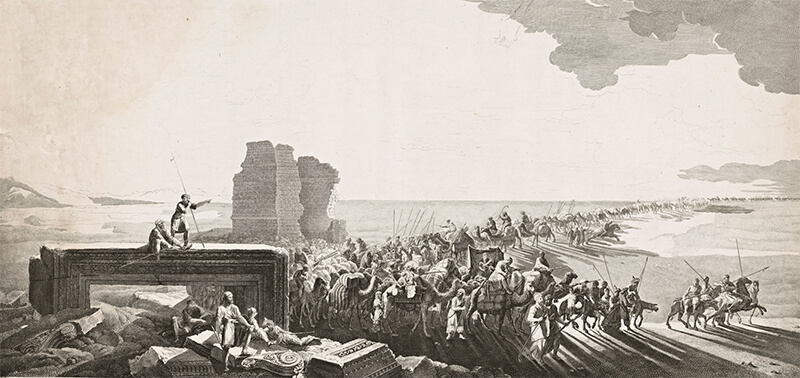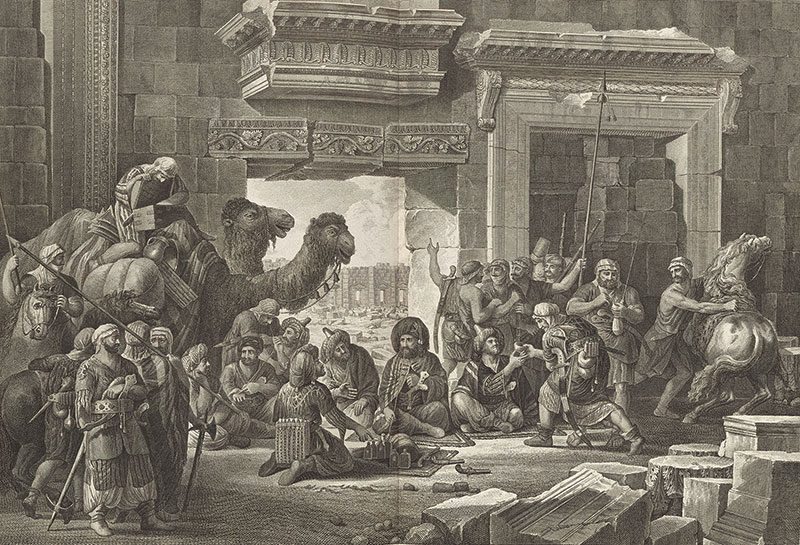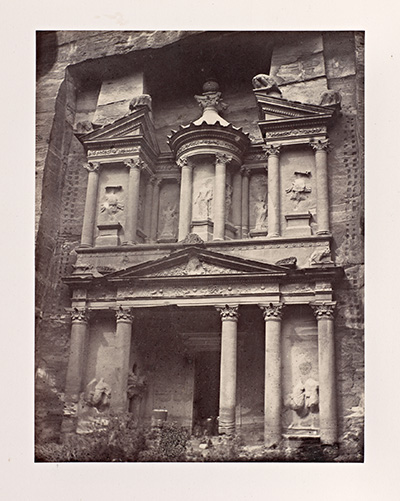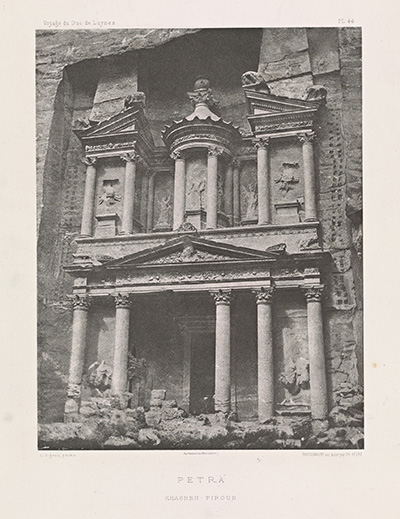
- Louis-François Cassas
Printmaker - Louis Vignes
Photographer
Back to top 

Cite this exhibition
Exhibition URL: www.getty.edu/palmyra
Cite this page
Terpak, Frances; Bonfitto, Peter Louis, The Legacy of Ancient Palmyra, Creating Palmyra's Legacy,
accessed ,
https://www.getty.edu/research/exhibitions_events/exhibitions/palmyra/exhibition.html


In this 21st century, war in Syria has irrevocably changed the ancient caravan city of Palmyra, famed as a meeting place of civilizations since its apogee in the mid-2nd to 3rd century CE. The Romans and Parthians knew Palmyra as a wealthy oasis metropolis, a center of culture and trade on the edge of their empires. Stretching some three kilometers across the Tadmurean desert, the ruins of Palmyra, like all ruins, stand as bearers of meaning marking their place in history. For centuries, traveling artists and explorers have documented the site in former states of preservation. Created as a tribute to Palmyra, this online exhibition captures the site as it was photographed for the first time by Louis Vignes in 1864 and illustrated in the 18th century by the architect Louis-François Cassas. Their works contribute to Palmyra's legacy, one that goes far beyond the stones of its once great buildings.



“Every part of Palmyra’s terrain is considerably enhanced by monumental rubble. There are columns and capitals overturned in the middle of entablatures and door frames, richly adorned and half broken. Beyond all these wonderful ruins, extends an ocean of blazing sand stretching all the way back to the horizon that appears to shimmer like a blue sea.”
–Louis-François Cassas
Louis-François Cassas recounting his 1785
entry into Palmyra. Unpublished manuscript
(p. 15). Getty Research Institute, 840011
In 1784 French artist and architect Louis-François Cassas (1756–1827) traveled to the Eastern Mediterranean as part of a diplomatic mission to the Ottoman court. Cassas was commissioned by French Ambassador Marie-Gabriel-Florent-Auguste de Choiseul-Gouffier, an antiquarian and author of important works on Greece's classical past, to record the monuments of Egypt, Syria, Lebanon, Cyprus, Palestine, and Asia Minor.

During this three-year expedition, Cassas created hundreds of drawings that formed the basis of his 1799–1800 publication Voyage pittoresque de la Syrie, de la Phoénicie, de la Palestine, et de la Basse Egypte. The more than 100 large-format etchings representing Palmyra, which appear in the first volume of this publication, constitute nearly one-third of its illustrations. In 1984 Getty Research Institute acquired an extraordinary collection of "proof" or trial prints made after drawings that Cassas produced during his voyage, in addition to a manuscript written in preparation for the publication. This unpublished manuscript provides detailed notes on the architectural splendors of Palmyra's tombs, temples, aqueducts, arches, porticoes, sculptures, and friezes, with an added précis of its history, rediscovery, and exploration.
Arriving in Palmyra on either May 22 or 23, 1785, Cassas assiduously worked to record the immense quantity of ruins scattered across the landscape until departing a month later with a caravan of 500 camels heading on to Baalbek in modern-day Lebanon. Aspiring to surpass earlier publications on Palmyra, Cassas wanted to awe and inspire his European audience by lavishly documenting this great ancient city surrounded by the desert. His panoramic etchings conform to the voyage pittoresque tradition, inviting the viewer to simultaneously marvel at the grandeur of antiquity and lament its inevitable decay. An amalgamation of orientalism and antiquarianism, the prints made from his drawings show local Bedouins inhabiting a dramatic landscape strewn with antique blocks, Corinthian columns, and monumental doorways. His primary objective to systematically record the artistry and ingenuity of this civilization is evident from Cassas's numerous technical renderings of the imposing civic and religious architecture. Floor plans and reconstructed architectural elevations are complemented by details of ornamental features.

After returning to France, Cassas became a professor of drawing at the renowned Gobelins Manufactory, where he most likely used his own ornament studies for teaching. By recasting his drawings into etchings for publication, Cassas created ready sources of inspiration for architects, painters, and designers working in the decorative arts.


Produced some 75 years after Cassas’s etchings, these pioneering photographs of Palmyra complement the prints to create an unparalleled visual record of this extraordinary ancient site.

Photographing the ancient ruins of Palmyra was the vision of French nobleman Honoré Théodore Paul Joseph d'Albert, duc de Luynes (1802–1867), an exceptional savant with varied interests ranging from archaeology, natural history, metallurgy, and chemistry to collecting antique works of art. In 1864 Luynes assembled a scientific expedition to the Dead Sea that included surveying the Transjordan region and exploring the famous rock-hewn city of Petra. For these investigations, he recruited several scientists including naval lieutenant Louis Vignes (1831–96) because of Vignes's navigational skills and knowledge of eastern Mediterranean ports. To visually record the sites reached on his self-funded expedition, Luynes had Vignes trained in photography by artist and photographer Charles Nègre. After the completion of much of the mission, Luynes returned to Paris, leaving Vignes to continue to Palmyra via Beirut.

Luynes was a committed enthusiast of the newly invented medium of photography, particularly its potential to be translated into a more stable photomechanical process. He commissioned Nègre to print the glass, or occasional paper, negatives produced by Vignes, and then to mass-produce the images for publication with a special photoengraving process developed by Nègre himself. However, because of the duc's untimely death in 1867, only the Dead Sea, Petra, and Transjordan images were made into photoengravings, and thus only they appear in the multivolume, posthumously published report Voyage d'exploration à la mer Morte, à Petra, et sur la rive gauche du Jourdain (1874).


Until their acquisition in 2015 by Getty Research Institute, the Palmyra photographs featured in this exhibition were largely unknown because they had remained in the possession of the Luynes family and never appeared as photoengravings. Printed by Nègre, probably soon after Vignes's return, these three dozen photographs of Palmyra are extremely rare and, in some cases, unique prints. They are the earliest known photographic images of the ruins, making Vignes the first to aim the camera's lens on the monuments. Produced some 75 years after Cassas's etchings, these pioneering photographs of Palmyra complement the prints to create an unparalleled visual record of this extraordinary ancient site.
Banner image: